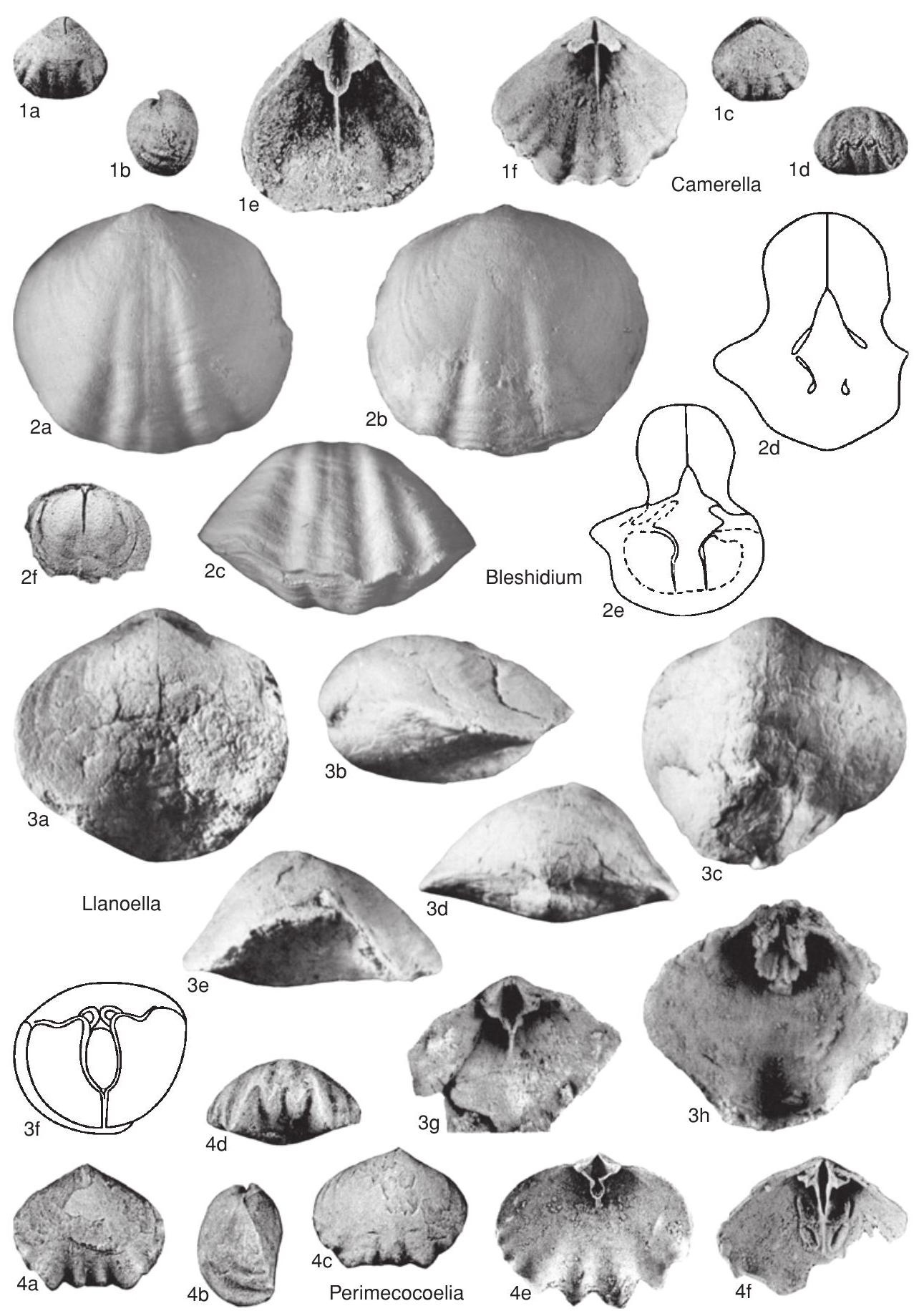Welcome to the Treatise on Invertebrate Paleontology!
Please enter a genera name to retrieve more information.

Camerella
Classification
Phylum:
Brachiopoda
Subphylum:
Rhynchonelliformea
Class:
Rhynchonellata
Order:
Pentamerida
Suborder:
Syntrophiidina
Superfamily:
Camerelloidea
Family:
Camerellidae
Subfamily:
Camerellinae
Formal Genus Name and Reference:
Camerella BILLINGS, 1859b, p. 301
Type Species:
C. volborthi, SD Hall & CLARKE, 1893, p. 219
Images
(Click to enlarge in a new window)
Fig. 636, 1a-d. *C. volborthi, upper Llanvirn, Rockland Formation, Ontario, Canada, a, ventral valve exterior, b, articulated valves, lateral view, ventral valve right, c, dorsal valve exterior, d, articulated valves, anterior view, ventral below, x2 (Cooper, 1956a)., Fig. 636, 1e-f. C. bella Fenton, upper Llanvirn, Macy Formation, Missouri, USA, e, ventral valve interior, f, dorsal valve interior, x2 (Cooper, 1956a).
Synonyms
Camarella
Geographic Distribution
Canada, USA, Britain, northern Europe, Russia, Siberia, Kazakhstan, China, Mongolia, ?India, ?Bolivia
Age Range
Beginning Stage in Treatise Usage:
Lower Ordovician (upper Llanvirn)
Beginning International Stage:
Darriwilian
Fraction Up In Beginning Stage:
30
Beginning Date:
466.05
Ending Stage in Treatise Usage:
Silurian (Wenlock)
Ending International Stage:
Homerian
Fraction Up In Ending Stage:
100
Ending Date:
426.74
Description
Most species small, some moderate in size, type species and most others paucicostate, some species with strong costae on the entire valve, few species with tiny granules or bumps over the surface, uniplication commonly present on the anterior third of the valve only, teeth small, relatively long spondylium simplex, rarely duplex, short, deep outer hinge plates, nearly horizontal in some species, long, narrow inner hinge plates converge and unite with a long median septum to form a short, deep, narrow septalium duplex, short, rodlike crura visible in some species, not the type species, dorsal adductor muscle field weakly developed.
References
Museum or Author Information
Classification
Phylum:
Brachiopoda
Subphylum:
Rhynchonelliformea
Class:
Rhynchonellata
Order:
Pentamerida
Suborder:
Syntrophiidina
Superfamily:
Camerelloidea
Family:
Camerellidae
Subfamily:
Camerellinae
Formal Genus Name and Reference:
Camerella BILLINGS, 1859b, p. 301
Type Species:
C. volborthi, SD Hall & CLARKE, 1893, p. 219
Images
(Click to enlarge in a new window)
Fig. 636, 1a-d. *C. volborthi, upper Llanvirn, Rockland Formation, Ontario, Canada, a, ventral valve exterior, b, articulated valves, lateral view, ventral valve right, c, dorsal valve exterior, d, articulated valves, anterior view, ventral below, x2 (Cooper, 1956a)., Fig. 636, 1e-f. C. bella Fenton, upper Llanvirn, Macy Formation, Missouri, USA, e, ventral valve interior, f, dorsal valve interior, x2 (Cooper, 1956a).
Synonyms
Camarella
Geographic Distribution
Canada, USA, Britain, northern Europe, Russia, Siberia, Kazakhstan, China, Mongolia, ?India, ?Bolivia
Age Range
Beginning Stage in Treatise Usage:
Lower Ordovician (upper Llanvirn)
Beginning International Stage:
Darriwilian
Fraction Up In Beginning Stage:
30
Beginning Date:
466.05
Ending Stage in Treatise Usage:
Silurian (Wenlock)
Ending International Stage:
Homerian
Fraction Up In Ending Stage:
100
Ending Date:
426.74
Description
Most species small, some moderate in size, type species and most others paucicostate, some species with strong costae on the entire valve, few species with tiny granules or bumps over the surface, uniplication commonly present on the anterior third of the valve only, teeth small, relatively long spondylium simplex, rarely duplex, short, deep outer hinge plates, nearly horizontal in some species, long, narrow inner hinge plates converge and unite with a long median septum to form a short, deep, narrow septalium duplex, short, rodlike crura visible in some species, not the type species, dorsal adductor muscle field weakly developed.
